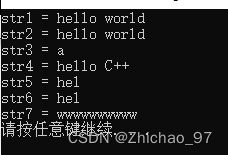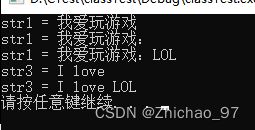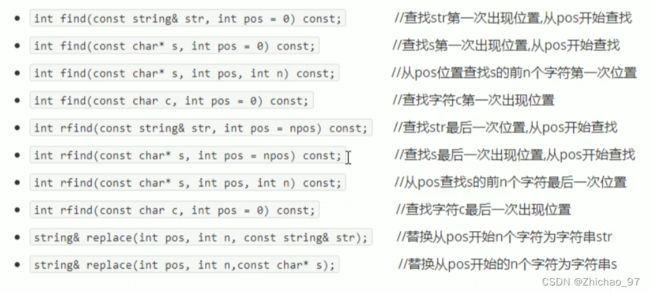C++ string容器
目录
1. string基本概念本质
2. string构造函数
3. string赋值操作
4. string字符串拼接
5. string查找和替换
6. string字符串比较
7. string字符存取
8. string插入和删除
9. string子串
1. string基本概念本质
本质:
string是C++风格的字符串,而string本质上是一个类
string和char*区别:
1.char*是一个指针
2.string是一个类,类内部封装了char*,管理这个字符串,是一个char*型的容器。
特点:
1.string类内部封装了很多成员方法,例如:查找find,拷贝copy,删除delete替换replace,插入insert
2.string管理char*所分配的内存,不用担心复制越界和取值越界等,由类内部进行负责
2. string构造函数
构造函数原型:
| string(); | 创建一个空的字符串,例如:string str; |
| string(const char* s); | 使用字符串s初始化 |
| string(const string& str); | 使用一个string对象初始化另一个string对象 |
| string(int n, char c); | 使用n个字符c初始化 |
示例:
#include
using namespace std;
#include
void test01()
{
//创建一个空的字符串
string s1;
//使用字符串str初始化
const char * str = "hello world";
string s2(str);
cout << "s2 = " << s2 << endl;
//使用一个string对象初始化另一个string对象
string s3(s2);
cout << "s3 = " << s3 << endl;
//使用10个字符a初始化
string s4(10, 'a');
cout << "s4 = " << s4 << endl;
}
int main() {
test01();
system("pause");
return 0;
} 结果:
3. string赋值操作
功能:给string字符串进行赋值
赋值的函数原型:
| string& operator=(const char* s); | char*类型字符串 赋值给当前的字符串 |
| string& operator=(const string &s); | 把字符串s赋给当前的字符串 |
| string& operator=(char c); | 字符赋值给当前的字符串 |
| string& assign(const char* s); | 把字符串s赋给当前的字符串 |
| string& assign(const char* s, int n); | 把字符串s的前n个字符赋给当前的字符串 |
| string& assign(const string &s); | 把字符串s赋给当前的字符串 |
| string& assign(int n, char c); | 用n个字符c赋给当前字符串 |
示例:
#include
using namespace std;
#include
void test01()
{
string str1;
str1 = "hello world";
cout << "str1 = " << str1 << endl;
string str2;
str2 = str1;
cout << "str2 = " << str2 << endl;
string str3;
str3 = 'a';
cout << "str3 = " << str3 << endl;
string str4;
str4.assign("hello C++");
cout << "str4 = " << str4 << endl;
string str5;
str5.assign("hello C++",3);
cout << "str5 = " << str5 << endl;
string str6;
str6.assign(str5);
cout << "str6 = " << str6 << endl;
string str7;
str7.assign(10,'w');
cout << "str7 = " << str7 << endl;
}
int main() {
test01();
system("pause");
return 0;
} 结果:
4. string字符串拼接
功能:实现在字符串末尾拼接字符串
函数原型:
示例:
#include
using namespace std;
#include
void test01()
{
string str1 = "我";
str1 += "爱玩游戏";
cout << "str1 = " << str1 << endl;
str1 += ":";
cout << "str1 = " << str1 << endl;
string str2 = "LOL";
str1 += str2;
cout << "str1 = " << str1 << endl;
string str3 = "I";
str3.append(" love ");
cout << "str3 = " << str3 << endl;
str3.append(str2, 0, 3);
cout << "str3 = " << str3 << endl;
}
int main() {
test01();
system("pause");
return 0;
} 结果:
5. string查找和替换
功能:
查找:查找指定字符串是否存在
替换:在指定的位置替换字符串
函数原型:
示例:
#include
using namespace std;
#include
//查找
void test01()
{
string str1 = "abcdedefg";
int pos = str1.find("de" ,0);
cout << "pos = " << pos << endl;
pos = str1.rfind("de");
cout << "pos = " << pos << endl;
}
//替换
void test02()
{
string str1 = "abcdedefg";
str1.replace(1, 3, "1111"); //从位置1到位置3的字符替换为1111
cout << "str1 = " << str1 << endl;
}
int main() {
test01();
test02();
system("pause");
return 0;
} 结果:
总结:
find查找是从左往后,rfind从右往左
find找到字符串后返回查找的第一个字符位置,找不到返回-1
replace在替换时,要指定从哪个位置起,多少个字符,替换成什么样的字符串
6. string字符串比较
功能:
字符串之间的比较
比较方式:
字符串比较是按字符的ASCIlI码进行对比
=返回0
>返回1
<返回-1
函数原型:
示例:
#include
using namespace std;
#include
void test01()
{
string str1 = "hello";
string str2 = "hello";
if (str1.compare(str2) == 0)
{
cout << "str1 等于 str2" << endl;
}
else if (str1.compare(str2) > 0)
{
cout << "str1 大于 str2" << endl;
}
else
{
cout << "str1 小于 str2" << endl;
}
}
int main() {
test01();
system("pause");
return 0;
} 结果:
7. string字符存取
string单个字符存取方式有两种
示例:
#include
using namespace std;
#include
void test01()
{
string str = "hello";
//通过[]访问单个字符
for (int i = 0; i < str.size(); i++)
{
cout << str[i] << " ";
}
cout << endl;
//通过at方式访问单个字符
for (int i = 0; i < str.size(); i++)
{
cout << str.at(i) << " ";
}
cout << endl;
}
int main() {
test01();
system("pause");
return 0;
} 结果:
8. string插入和删除
功能:
对string字符串进行插入和删除字符操作
函数原型:
示例:
#include
using namespace std;
#include
void test01()
{
string str = "hello";
//插入string
str.insert(1, "111");
cout << "str = " << str << endl;
//删除string
str.erase(1, 3);
cout << "str = " << str << endl;
}
int main() {
test01();
system("pause");
return 0;
} 结果:
9. string子串
功能:
从字符串中获取想要的子串
函数原型:
示例:
#include
using namespace std;
#include
void test01()
{
string str = "hello";
string subStr = str.substr(1, 3);
cout << "subStr = " << subStr << endl;
}
int main() {
test01();
system("pause");
return 0;
} 结果:
实用操作:
从邮箱地址中截取账户名
#include
using namespace std;
#include
void test01()
{
string email = "[email protected]";
int pos = email.find("@");
string usrName = email.substr(0, pos);
cout << usrName << endl;
}
int main() {
test01();
system("pause");
return 0;
} 结果:














